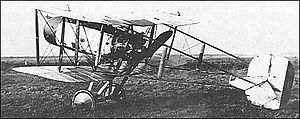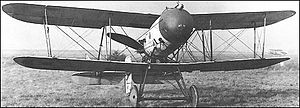Vickers F.B.12 Video - Picture

|
|
Vickers F.B.12
F.B.12

Role: Fighter
National origin: United Kingdom
Manufacturer: Vickers Limited
First flight: July 1916
Number built: ~22
The Vickers F.B.12 was a biplane pusher fighter aircraft developed during World War I by Vickers Limited
Development and design
At the start of the First World War, Vickers entered into a partnership with the Hart Engine Company to develop a 150 hp (110 kW) nine-cyliner radial engine designed by Hart. This engine was planned to power a number of new designs by Vickers, the first of which was a small single-engine pusher biplane fighter, the F.B.12.
The F.B.12 resembled the D.H.2 and F.E.8; wood and fabric wings with rounded tips. The circular nacelle was framed in steel tubing, with the engine directly behind the cockpit, driving a wooden propeller. The tail was at the end of an open steel boom. A .303 in (7.7 mm) machine gun was placed inside the front of the nacelle, with only the barrel protruding.

Picture - Vickers F.B.12
The first FB.12 flew in June 1916, powered by a 80 hp (60 kW) Le Rhx´ne rotary engine as the Hart was not yet available. With this engine, it proved to be underpowered and was re-fitted with a 100 hp (75 kW) Gnome Monosoupape engine. It was then rebuilt with increased wing span and area, becoming the F.B.12A. In December 1916 it was sent to France for operational testing, where it was deemed as good as the D.H.2 and F.E.8, but still outclassed by the German aircraft.
The F.B.12B was similar to the F.B.12A, but fitted with the originally intended Hart engine, flying early in 1917. In November 1916, meanwhile, the War Office placed an order for 50 Hart powered aircraft, designated the F.B.12C for the RFC. The F.B.12B crashed during tests in early 1917, leading to Vickers abandoning the Hart. Only 18 of the order were built, being fitted with a number of different engines including a 110 hp (80 kW) Le Rhx´ne and a 100 hp (75 kW) Anzani radial. Tested between May and July 1917, only 1 F.B.12C was delivered, to the Home Defense unit.
The F.B.12D was the final variation, only 1 prototype was produced with a larger 110 hp (80 kW) Le Rhone engine.
Operators
United Kingdom
Royal Flying Corps
Variants
F.B.12 F.B.12a Mono-Gnome engine F.B.12b 150 hp (110 kW) Hart radial engine F.B.12c flat-sided nacelle, larger fin and rudder. 18 production aircraft built. F.B.12d 110 hp (80 kW) Le Rhone or 100 hp (75 kW) Gnome Monosoupape engine
Specifications (F.B.12)
Data from War Planes of the First World War: Volume Three
General characteristics
Crew: 1
Length: 21 ft 6 in (6.55 m)
Wingspan: 26 ft in (7.93 m)
Height: 8 ft 8 in (2.64 m)
Wing area: 204 ft² (19.0 m²)
Empty weight: 845 lb (384 kg)
Gross weight: 1,275 lb (580 kg)
Powerplant: 1 x— Gnome Monosoupape nine-cylinder rotary engine, 100 hp (75 kW)
Performance
Maximum speed: 86 mph (138 km/h)
Endurance: 3 hours
Service ceiling: 11,500 ft (3,500 m)
Armament
One .303 in Lewis gun
Bibliography
Bruce, J.M. (1969). War Planes of the First World War: Volume Three Fighters. london: Macdonald. ISBN 356 01490 8. .
Lamberton, W.M. (1960). Fighter Aircraft of the 1914-1918 War. Herts: Harleyford Publications Ltd.. .
Vickers F.B.12 Pictures
Living Warbirds: The best warbirds DVD series.
Source: WikiPedia